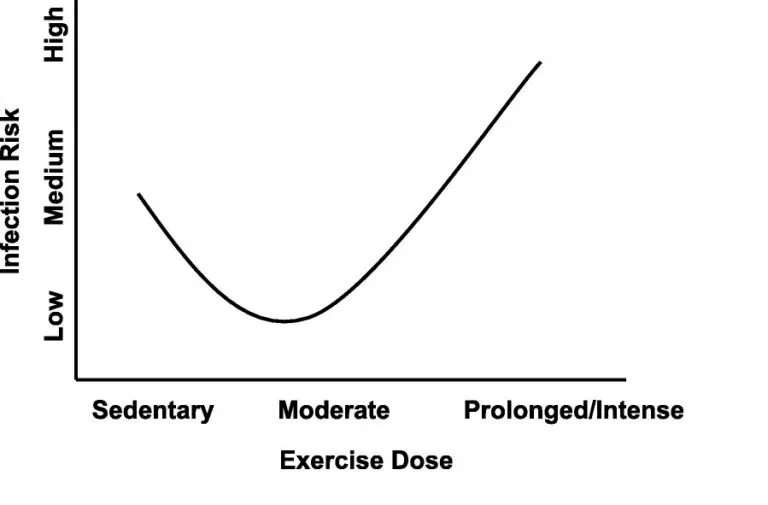A little while ago while running the trails I was contemplating: Is running in New Hampshire good for your health? Specifically, is it wise to be running more than usual during the pandemic we have going on? I know that I am running more! Then I remembered this study I read some time ago (this article) that looked at the impact of different levels of exercise (running in particular) on respiratory infections and shot this quick video.
(In the video I keep saying “respiratory illness.” I really meant to say “infection” instead).
If you like details… I’ll get into it in a bit. If you want the bottom line… Here it is: “moderate” running seems to protect you from respiratory infections such as flu and the common cold. Sitting on the couch can raise your odds of catching an infection. And here’s the kicker… “extreme” running can increase your odds of catching a bug as well. I don’t claim to be an infectious disease specialist nor do I claim to have the cure for the Coronavirus we are dealing with right now. But I do think we can learn something from this study whether you are an exercise fanatic or spend most of your day at a desk or on the couch.
You Are A Moderate Runner
Good for you! You make the time for yourself and get outside or on the treadmill to get in 15 miles a week or so. Your body responds by a shift in your immune system and lowering inflammation what seems to lower your odds of catching a virus as well as decreasing the impact of a virus. Maybe you feel like increasing your weekly mileage or your long run distance. Go for it! Just do it gradually.
You Are Running Miles And Miles And Always Have
If you aren’t making big changes in your training schedule and are feeling good (no injuries, you don’t feel tired) you should probably just carry on as you are. However, in one study they found that their group of runners that ran 60+ miles a week had twice the risk of developing a respiratory infection than the 15 miles/week group.
The problems start when you are heaping it on. Say you act like you are getting ready for a marathon by increasing intensity of your runs and/or your weekly mileage. This takes a toll on your immune system. If you are worried about your ability to fight respiratory infections this may not be the time to really push it. Progress your program more gradually.
You are running off mental stress and maaaaaybe doing a little more than you should
You know who you are happy. And you should know you are not alone. We have seen people and heard from people who got into some trouble by upping their running by a lot. Trouble ranging from joint and tendon pain to a stress fracture of the hip. If you are overdoing it, ramping up too quick, not taking enough rest, you may be putting yourself at risk for depleting your immune system and becoming more vulnerable to respiratory infections as well. By all means use running and exercise as a healthy, effective way to help you navigate these stressful times but keep listening to your body! Ramp up slowly, rest, watch out for fatigue and aches.
Couch potatoes and desk jockeys: we’ve got the best news for you!
This study has the best news for you non-or-hardly-exercising folks. You may think that, in order to benefit from this protective mechanism that running offers, you need to look and act like a running goddess or god who has been running for years. NOT TRUE! The benefit is related to the activity, not to the fitness level! That’s surprising right? Exercising daily for less than a week actually has a significant protecting effect (in a study of mouse “volunteers” exposed to a flu virus and little mouse treadmills). So there you go: get out there. Walk, run or alternate running and walking daily for 20-30 minutes of moderate exercise. If you need help, or have aches and pains preventing you from doing this click this link and contact us.
A quick summary of this study

If you are up to it, read this journal article. Skip over the really complex stuff and read the parts that are in English. From observation it was determined that infection risk in relation to exercise habits followed the J-curve in the image above. Some experimenting was done on people. Of course this was limited as you probably shouldn’t give anyone flu in the name of science. Enter the lab mice. You can question whether it’s OK to give a mouse flu… Well, they did. They exposed mice to flu then had them:
- Do nothing.
- Exercise 30 minutes a day for 4 days (moderate).
- Exercise 150 minutes a day for 4 days (prolonged).
Result: Fewer mice got sick and fewer mice died in the moderate exercise group (group 2) than in the other groups. The prolonged exercise group had similar numbers of sick mice than the sedentary mice, but a higher number of them died. This fits the observations that were made in humans!
My apologies about the mice. That’s a bummer to end on. The message is a positive one though: get out there, enjoy the fall weather, exercise in moderation. Running IS good for your health!
Infection risk follows the curve described in the graph at the top (from: Exercise and Respiratory Tract Viral Infections, Martin, Stephen A.1,2; Pence, Brandt D.1,2; Woods, Jeffrey A.1,2,3,4. Exercise and Sport Sciences Reviews: October 2009 – Volume 37 – Issue 4 – p 157-164 doi: 10.1097/JES.0b013e3181b7b57b) https://journals.lww.com/acsm-essr/Fulltext/2009/10000/Exercise_and_Respiratory_Tract_Viral_Infections.3.aspx


